




It's at the tops of trees and tips of limbs where most budding, branching and photosynthesis occur. It's here, where the forest meets the sky, that scientists need to learn how trees absorb carbon dioxide and how the forest helps cool the planet.
But if you are studying old growth forests, your research site can be more than 200 feet in the sky. Simply getting to the first branch of a Douglas-fir giant can involve firing ropes with bows and arrows, rigging long lines and having the strength of Tarzan to be able to pull yourself hundreds of feet into the air.
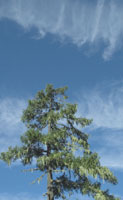 Ten years ago the University of Washington and its partners found a solution to the problems of studying the old growth forest canopy-a 25-story-tall construction crane, the largest forest research crane in the world. Located in the Wind River Experimental Forest near the Columbia River Gorge in southwest Washington, it has been the destination for more than 300 scientists to study how old growth forests function.
Ten years ago the University of Washington and its partners found a solution to the problems of studying the old growth forest canopy-a 25-story-tall construction crane, the largest forest research crane in the world. Located in the Wind River Experimental Forest near the Columbia River Gorge in southwest Washington, it has been the destination for more than 300 scientists to study how old growth forests function.
While scientists have studied the tropical rain forest canopy for years with cranes, this is the first extensive study of the temperate forest canopy. The results could be profound since most of the world's population-in North America, Europe, most of China and large portions of Russia-live near temperate forests.
 Tropical rain forests are often praised as storehouses for excess carbon in the atmosphere, which is a possible cause of global warming. What researchers atop the Wind River crane have discovered is an even better source for "banking" excess carbon-temperate conifer forests.
Tropical rain forests are often praised as storehouses for excess carbon in the atmosphere, which is a possible cause of global warming. What researchers atop the Wind River crane have discovered is an even better source for "banking" excess carbon-temperate conifer forests.
"What we've found at Wind River in just the last five years is that the forest has the capacity to store carbon better than any other ecosystem in the world, certainly more than tropical forests on a per-acre basis," says UW Forest Resources Professor Jerry Franklin, the guiding force behind the crane.
The amount of carbon stored in that stand is immense, at least 178 tons per acre. Researchers are finding that (unless conditions are very dry) the forest over the course of a year doesn't give off more carbon than it absorbs-it doesn't leak carbon as some had thought. And some years, when conditions are right, the forest soaks up considerably more than it loses.
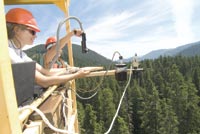
"If what's happening at Wind River is typical of the Pacific Northwest, then we may have a huge capacity to store carbon in our forests by, for example, giving landowners incentives to grow forests longer," Franklin says.
Forest Resources Professor Dave Peterson, who is also a research forester with the Forest Service's Pacific Northwest Research Station, says that active management to store carbon in living trees and wood products may be able to soak up 30 percent of current levels of carbon dioxide produced in the region.
The Wind River Canopy Crane was erected in 1995 as a cooperative venture of the Gifford Pinchot National Forest and the Pacific Northwest Research Station, both part of the USDA Forest Service, and the University of Washington. Because of the sensitive research and potential danger, it is not open to the public.
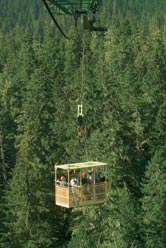
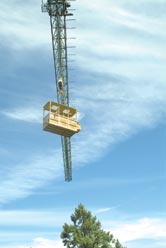
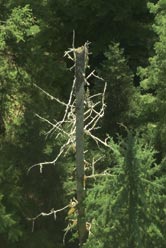
Go To: Page 1 | Page 2